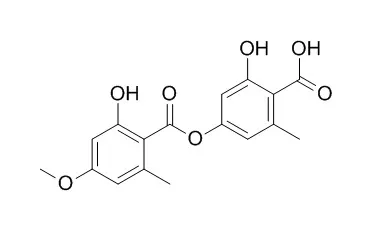| In vitro: |
| Natural Product Communications, 2014, 9(4):503-504. | | Clastogenic effect of atranorin, evernic acid, and usnic acid on human lymphocytes.[Reference: WebLink] |
METHODS AND RESULTS:
Three lichen secondary metabolites atranorin (1), Evernic acid (2), and usnic acid (3), were evaluated for their in vitro clastogenic and antiproliferative effects on human lymphocytes using the cytochalasin-B blocked micronucleus (CBMN) assay at concentrations of 2 microg/mL, 4 microg/mL and 6 microg/mL of final culture solution. The frequency of micronucleus (MN) was scored in binucleated cells, and cytokinesis-block proliferation index (CBPI) was calculated. Among the tested compounds, 3 exhibited the most prominent effect decreasing the frequency of MN in the range of 42.5% - 48.9%, that is about double of the positive control amifostin WR-2721 that reduces MN frequency for 22.0%. The effect of Evernic acid was approximately equal to action of amifostin (23.2% -32.9%). Atranorin at concentrations of 2 microg/mL and 4 microg/mL decreasing the frequency of MN only for 11.1% and 1.8%, while in concentration of 6 microg/mL increases the frequency of MN for 9.6 %.
CONCLUSIONS:
The comparable CBPI values of the investigated compounds and control suggested that they did not show a statistically significant inhibitory effect on lymphocyte cell proliferation at applied concentrations. | | Planta Medica, 2009, 75(06):607-613. | | Antiproliferative effects on tumour cells and promotion of keratinocyte wound healing by different lichen compounds.[Reference: WebLink] | Five compounds representative of major structural classes of lichen polyketides, VIZ. (+)-usnic (1), salazinic (2), vulpinic (3), gyrophoric (4), and Evernic acids (5), were investigated for their ability to affect cell proliferation or wound healing, two functional targets of relevance for research on cancer or tissue regeneration.
METHODS AND RESULTS:
The experiments were carried out on MM98 malignant mesothelioma cells, A431 vulvar carcinoma cells, and HaCaT keratinocytes. The NRU and CV cytotoxicity assays showed high toxicity for (+)-usnic acid, intermediate toxicity for vulpinic acid, and low toxicity for salazinic, gyrophoric and Evernic acids. Scratch wounding experiments on HaCaT monolayers, in the presence of subtoxic doses of lichen compounds, showed strong wound closure effects by (+)-usnic and gyrophoric acid, an intermediate effect by vulpinic and salazinic acids, and no effect by Evernic acid. A combination of (+)-usnic and gyrophoric acids gave a further increase in the wound closure rates.
The results of a cell migration test correlated with the wound healing data.
CONCLUSIONS:
In conclusion, (+)-usnic acid might be a particularly interesting compound for the prevention of hyperproliferation syndromes, while (+)-usnic and gyrophoric acids qualify as interesting leads in the promotion of tissue regeneration. |
|






 Cell. 2018 Jan 11;172(1-2):249-261.e12. doi: 10.1016/j.cell.2017.12.019.IF=36.216(2019)
Cell. 2018 Jan 11;172(1-2):249-261.e12. doi: 10.1016/j.cell.2017.12.019.IF=36.216(2019) Cell Metab. 2020 Mar 3;31(3):534-548.e5. doi: 10.1016/j.cmet.2020.01.002.IF=22.415(2019)
Cell Metab. 2020 Mar 3;31(3):534-548.e5. doi: 10.1016/j.cmet.2020.01.002.IF=22.415(2019) Mol Cell. 2017 Nov 16;68(4):673-685.e6. doi: 10.1016/j.molcel.2017.10.022.IF=14.548(2019)
Mol Cell. 2017 Nov 16;68(4):673-685.e6. doi: 10.1016/j.molcel.2017.10.022.IF=14.548(2019)